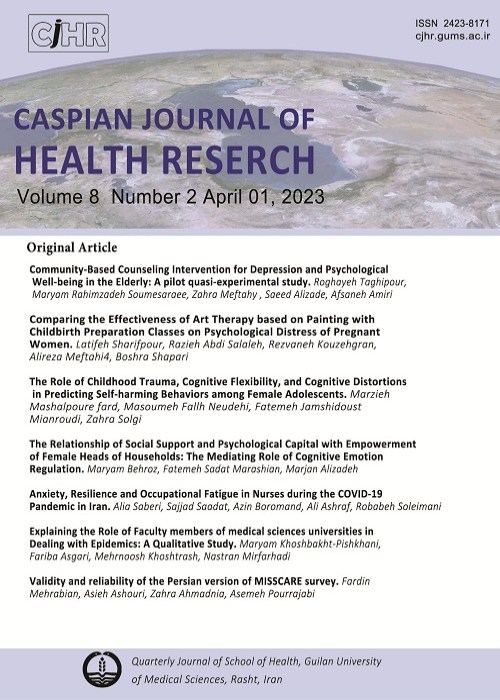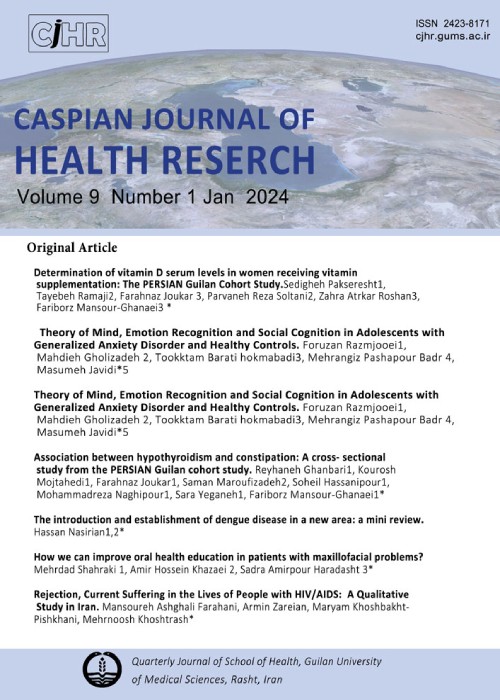فهرست مطالب

Caspian Journal of Health Research
Volume:8 Issue: 2, Apr 2023
- تاریخ انتشار: 1402/02/30
- تعداد عناوین: 7
-
-
Pages 65-74Background
It has been established that active aging should be a policy objective for aging societies.
Objectivesthe present study aimed to test the feasibility and effectiveness of a community-based counseling intervention for active aging.
Materials & MethodsThe current quasi-experimental study was conducted on all elderly men who were referred to Salmandan park, the southern side of Zayandeh Rood Bastar Park between the Khajo and Bozorgmehr bridges of Isfahan, Iran in 2022. A total of 30 people were selected through the convenience sampling method. The experimental group (n=15) received eight sessions (60 minutes sessions per week) of Community-based counseling intervention, while the control group (n=15) did not receive any training. Data were collected by Ryff's Psychological Well-Being Scale (PWB) and Geriatric Depression Scale (GDS).
ResultsActive aging protocol was effective in psychological well-being (F1,28=19.52; P<0.001, η2=0.764) and depression (F1,28=20.36; P<0.001, η2=0.791).
ConclusionThe findings revealed that the community-based counseling approach improved depression and psychological well-being in the elderly. Increasing evidence suggests that any meaningful activity is beneficial for different aspects of well-being in older people.
Keywords: Community-based counseling intervention, Aging, Depression, Psychological Well-being, Elderly -
Pages 75-84Background
Psychological distress is very common during pregnancy and threatens the health of both the mother and fetus. Non-pharmacological treatments are of priority to reduce the psychological distress of pregnant women.
ObjectivesThis study aimed to determine and compare the effectiveness of art therapy based on painting and childbirth preparation classes on the psychological distress of pregnant women in the third trimester of pregnancy.
Materials & MethodsThe present study was a quasi-experimental pretest-posttest design with a control group. The statistical population consisted of all pregnant women in the third trimester who were referred to health and treatment centers of Kerman in 2020, among whom 51 were selected by convenience sampling method and randomly assigned into three groups of art therapy based on painting, childbirth preparation classes, and a control group (n=17 in each group). Data were collected using Kessler psychological distress scale in two periods before and after the interventions. Art therapy based on a painting was performed in 12 sessions of 90 minutes weekly for the first experimental group for a month and a half. Childbirth preparation classes were performed in eight 90-minute weekly sessions for the second experimental group for two months. The control group received no intervention. Data were analyzed using univariate analysis of covariance and Bonferroni posthoc test.
ResultsThe mean (Standard deviation) of psychological distress in the art therapy based on the painting group decreased from 23.47 (0.89) in the pre-test to 8 (0.71) in the post-test (P<0.001). In the childbirth preparation class group, it decreased from 23 ±0.51 in the pre-test to 17.10 ±1. 01 in the post-test (P< 0.001). It showed that art therapy based on painting was found more effective in comparison with childbirth preparation classes (P< 0.05). While there was no difference in the psychological distress of the control group in the pre-test and post-test.
ConclusionsBoth interventions reduced the psychological distress of pregnant women in the third trimester. In comparison with the two interventions, art therapy based on painting was more effective in reducing psychological distress.
Keywords: Art Therapy, Painting Therapy, Childbirth Preparation Class, Psychological Distress, Pregnancy -
Pages 85-92Background
Increasing public health concerns are being raised about adolescent self-harming behaviors. The previous study indicates that childhood trauma can be related to self-harm.
ObjectivesThe study aimed to investigate the relationship between childhood trauma, cognitive flexibility, and cognitive distortions in predicting self-harming behaviors among female adolescents in Shahrood, Iran.
Materials & MethodsThe research method was cross-sectional. The statistical population of the study included all female students in the junior high schools of Shahrood, Iran in the academic year 2022-23. A sample of 220 female adolescents (aged 13–15) was recruited through multi-stage sampling. Participants had at least one self-harming behavior in their clinical records. The child Trauma Questionnaire (CTQ), Cognitive Flexibility Inventory-Iranian Version, The Cognitive Distortion Scale, and Self-Harm Behavior Questionnaire were completed. Data were analyzed using the Pearson correlation coefficient and multivariate linear regression model.
ResultsThe mean age of study participants was 13.70 (standard deviation=1.02), almost 73% of the samples were from 13 to 14 years old, and most students came from three- and four-member families (81%). Findings of multivariate linear regression revealed that childhood trauma (β=0.137, t=2.828) and cognitive distortions (β = 0.188, t=3.940) were positive and significant predictors of self-harming behaviors in adolescents. Moreover, Cognitive flexibility (β = -0.237, t=-4.957) was a negative and significant predictor of self-harming behaviors in adolescents.
ConclusionThe results of this study may have implications for increasing mental health awareness among students and school programs to prevent self-harm.
Keywords: Childhood trauma, Cognitive flexibility, Cognitive distortions, Self-harming behavior -
Pages 93-102Background
Female heads of households (FHHs) experience more anxiety and stress which result in many mood swings that can affect their belief in their capabilities and decrease the feeling of enjoyment of life.
ObjectiveThe present study aimed to investigate the relationship between social support and psychological capital with the empowerment of female heads of households through the mediating role of cognitive emotion regulation.
Materials & MethodsThe current descriptive cross-sectional study was performed on all female heads of households referring to Imam Khomeini Relief Foundation and the Welfare Department of Yasuj city, of whom, 250 were selected as the sample using convenience sampling method. The psychological empowerment instrument, the psychological capital questionnaire, the multidimensional scale of perceived social support, and the cognitive emotion regulation Questionnaire (short form) were used to collect data. Data were then analyzed using Pearson correlation coefficient and path analysis in SPSS and AMOS 25.
ResultsThe results showed that there was a positive correlation between empowerment and social support (r=0.29), psychological capital (r=0.44), and adaptive emotion regulation (r=0.36). Moreover, there was a negative correlation between empowerment and maladaptive emotion regulation (r=-0.35). The results showed that the indirect correlation of social support and psychological capital with the empowerment of the FHHs was significant through the mediating role of cognitive emotion regulation (P<0.001).
ConclusionsThe proposed model had a good fit. Empowering FHHs and improving their social support and psychological capital will enable them to deal with stress resulting from daily problems.
Keywords: Social Support, Emotions, Empowerment, Psychological Capital, Women -
Pages 103-110Background
The COVID-19 virus epidemic has caused a major physical and psychological burden on nurses in Iran and around the world.
ObjectivesThe purpose of this study was to investigate the role of anxiety and resilience in predicting occupational fatigue in nurses during the COVID ‐ 19 virus epidemic in Iran.
Materials & MethodsThis cross-sectional online survey was conducted on the nurses of Razi and Porsina public hospitals in Rasht, north of Iran. A total of 160 nurses of were selected using simple random sampling method. Data were collected using the Swedish occupational fatigue inventory (SOFI), the corona disease anxiety scale (CDAS) and the Connor-Davidson resilience scale (CD-RISC).
ResultsParticipation rate was 87.5%. The score level of most nurses in CDAS was low to moderate. The CDAS score was higher in women and those who work in the COVID units than those who work in both the COVID and non-COVID units. The CD-RISC score was higher in married people than singles and in people with permanent employment status than in contract and temporary employment status. SOFI was positively correlated with CDAS and negatively correlated with CD-RISC; But CDAS and CD-RISC were not significantly related (p<0.05). In multivariate linear regression model. Anxiety was the only significant independent predictor of occupational fatigue (B=1.16, P<0.001).
ConclusionDespite the COVID-19 epidemic crisis in the fourth wave and high mortality, anxiety level in nurses was low and moderate, which can be attributed to the COVID-19 vaccine. But the anxiety score still played an important role in occupational fatigue. It is suggested that appropriate interventions be developed and implemented to improve nurses' anxiety to stressful epidemic conditions of Covid-19 and thereafter.
Keywords: COVID-19, anxiety, resilience, occupational fatigue, nurses -
Pages 111-120Background
The roles of Faculty members of medical sciences universities in responding to and controlling critical situations and epidemic diseases are critical and of great importance.
ObjectiveThis study was aimed to explain the role of faculty members in dealing with epidemics and crises.
Materials and MethodsThis qualitative study was conducted using a content analysis method at Guilan University of Medical Sciences in 2020. Thirteen faculty members (physician, Ph.D. in nursing, anesthesiologist, PhD in reproductive health, and Ph.D. in disaster and emergency health) were selected through purposive sampling method, and their viewpoints were surveyed until data saturation was reached. Data were collected through semi-structured interviews. Qualitative content analysis was used to analyze the data.
ResultsBased on participants’ experiences, several roles could be considered under 3 main categories: a public educator, a clinical therapist, and a manager. Each of these main categories included several sub-categories. Based on the participants’ experiences, among faculty members’ roles, the public educator, as the most central role, influences other duties of faculty members.
ConclusionsThe results of this study showed that medical faculty members have numerous and significant roles in dealing with crises and emerging diseases. Identifying the medical faculty’s roles in coping with epidemics can help better understand the capabilities of these instructors and plan a basis for their greater cooperation and participation in controlling, preventing, and managing crises and emerging diseases. The results of this study can be advantageous in planning training programs and preparing faculty members to deal with epidemics and crises.
Keywords: Faculty, Epidemics, Education, Qualitative Research -
Pages 121-128Background
The MISSCARE survey is a useful instrument measuring the amount and type of missed nursing care and its important reasons, developed by Kalisch and Williams in 2009 and revised in 2019.
ObjectiveThe present paper aimed to report the psychometric properties of part A (missed nursing care) and part B (reasons for missed nursing care) of the MISSCARE tool translated into Persian.
Materials & MethodsA Persian version of the MISSCARE tool were evaluated by a panel of experts, and the psychometric properties were determined with 326 nurses randomly selected from non-emergency wards of seven educational and medical centers in Rasht, North of Iran. Nurses completed the instruments from January to March 2021. Content validity was evaluated by calculating content validity index (CVI). Confirmatory factor analysis (CFA) was used to assess construct validity. Internal consistency (reliability) was measured using Cronbach's alpha coefficient.
ResultsCVI was measured 0.82 and 0.79 for parts A and B of the survey. The fit indices of CFA indicated the acceptable fit for the measurement model of part B (missed nursing care reasons). Also, factor loadings of items on three factors of labor, material and communication confirmed the structural validity of part B of the survey. Cronbach’s alpha coefficients for parts A and B were 0.991 and 0.994 in whole, and Cronbach's alpha coefficient for three factors of part B ranged from 0.831 to 0.936 confirmed their reliability.
ConclusionsThe Persian version of the MISSCARE tool is valid and reliable for measuring missed nursing care and its reasons. It can be used by nursing authorities for evaluation purpose in Iranian hospitals.
Keywords: Validity, Reliability, Missed nursing care, MISSCARE, Persian


